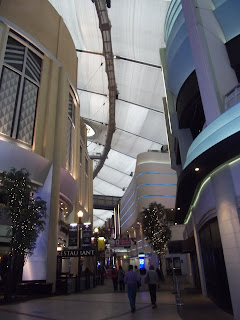The O2 - is a large entertainment district on the Greenwich peninsula, including an indoor area, a music club, a cinema, an exhibition space, piazzas, bars and restaurants. It was built largely within the former Millennium Dome, a large dome-shaped building built to house an exhibition celebrating the turn of the third millennium; as such, The Dome remains a name in common usage for the venue.
Exterior of the Dome -
Entrance hall –
Restaurant precinct –
Armadillo lunch stop – American food served at its best, milkshakes in milk bottles and stacked burgers on offer
Titanic Exhibition - On April 15, 1912, Titanic, the world’s largest ship sank after colliding with an iceberg, claiming more than 1,500 lives and shaking the world’s confidence in the infallibility of modern technology. This exhibition demonstrates the compelling stories, historically accurate room recreations, and more than 300 authentic artefacts recovered on our seven research expeditions since the Ship’s discovery in 1985.
HMS Belfast – is a museum ship museum, originally a Royal Navy light cruiser, permanently moored in London on the River Thames and operated by the Imperial War Museum.
Construction of Belfast, named after the capital city of Northern Ireland and one of ten Town class cruisers, began in December 1936. Commissioned in early August 1939 shortly before the outbreak of the WWII, Belfast was initially part of the British naval blockade against Germany.
In November 1939 Belfast struck a German mine and spent more than two years undergoing extensive repairs. Returning to action in November 1942 with improved firepower, radar equipment and armour, Belfast was the largest and arguably most powerful cruiser in the Royal Navy at the time.
Belfast saw action escorting Arctic convoys to the Soviet Union during 1943 and in December 1943 played an important role in the Battle of the North Cape, assisting in the destruction of the German warship Scharnhorst.
Belfast saw further combat action in 1950-52 during the Korean War and underwent an extensive modernisation between 1956 and 1959. A number of further overseas commissions followed before Belfast entered reserve in 1963.
Expected to be disposed of as scrap, in 1967 efforts were initiated to preserve Belfast as a museum ship. In 1971 the government decided against preservation, prompting the formation of the private HMS Belfast Trust to campaign for her preservation. The Trust was successful in its efforts, and the government transferred the ship to the Trust in July 1971. Opened to the public in October 1971 Belfast became a branch of the Imperial War Museum in 1978.





















No comments:
Post a Comment